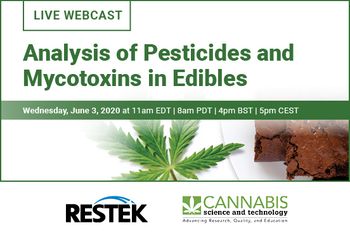
Quantitative LC-UV Method for CBD in Topicals with Simplified Extraction of Lotions, Balms, and Creams
A universal extraction method has been developed for the LC-UV analysis of cannabidiol (CBD) in infused lotions, balms, and creams.

A universal extraction method has been developed for the LC-UV analysis of cannabidiol (CBD) in infused lotions, balms, and creams.

Here, an effective workflow for this complex analysis was developed in brownies, and optimization strategies are detailed in order to provide a starting point for similar matrices.

With more cannabinoid acids than other standards on the market, Restek’s newest certified reference material offers a simpler solution for cannabis and hemp potency testing.

In this work, we describe a complete workflow for the analysis of California pesticides, mycotoxins, and cannabinoids in gummies using a single extraction procedure.

Restek’s new Terpenes MegaMix standards features 59 compounds across two ampuls, helping labs analyze an extensive terpenes list without needing to combine multiple mixes or terpene singles.

In this work, we describe a complete workflow for the analysis of California pesticides, mycotoxins, and cannabinoids in gummies using a single extraction procedure.

An effective workflow for this complex analysis was developed in brownies, and optimization strategies are detailed in order to provide a starting point for similar matrices.

This application note demonstrates Cannabinoid Profiles on Raptor ARC-18 column.

It is critically important to test if pesticides and mycotoxins are present in cannabis and cannabis products. Join Dr. Nathaly Reyes as she shares a workflow for the analysis of these compounds in edibles.

We know cannabis is complex, so where do we start. Nontargeted screening provides a wealth of information about the chemical constituents that are found in cannabis samples. This presentation demonstrates technology that takes us one step closer to answering “what’s all in there?”.

Potency testing and cannabinoid profiling are high-demand tests that can be improved by increasing speed, expanding analyte lists, and reducing costs.

As the cannabis market grows, interest in more detailed analysis of cannabinoid profiles is expanding because more comprehensive data can be used for strain identification as well as to ensure more accurate potency testing. The LC-UV method shown here uses a Raptor ARC-18 column to fully resolve 16 major and most frequently observed minor cannabinoids for which commercial standards are available.

As the cannabis market grows, interest in more detailed analysis of cannabinoid profiles is expanding because more comprehensive data can be used for strain identification as well as to ensure more accurate potency testing. The LC-UV method shown here uses a Raptor ARC-18 column to fully resolve 16 major and most frequently observed minor cannabinoids for which commercial standards are available.

As shown here, the retention and selec¬tivity of the Raptor Biphenyl column allow new drugs to be added to an existing method, providing labs with an important vehicle for improving efficiency and productivity.

The retention and selectivity of the Raptor Biphenyl column allow new drugs to be added to an existing method.

The analysis of synthetic cannabinoids and their metabolites can be a difficult and challenging task. Keeping up with the ever-growing list of synthetic cannabinoids that illicit drugmakers produce further complicates the analysis. As shown here, the retention and selectivity of the Raptor Biphenyl column allow new drugs to be added to an existing method, providing labs with an important vehicle for improving efficiency and productivity.

Cannabinoid Profiles on Raptor ARC-18 - High Throughput Analysis of Cannabinoids by LC-UV

Cannabinoid Profiles on Raptor ARC-18

Published: December 16th 2021 | Updated:

Published: October 8th 2021 | Updated:

Published: August 4th 2020 | Updated:

Published: September 30th 2021 | Updated:

Published: October 5th 2018 | Updated:

Published: February 13th 2019 | Updated: